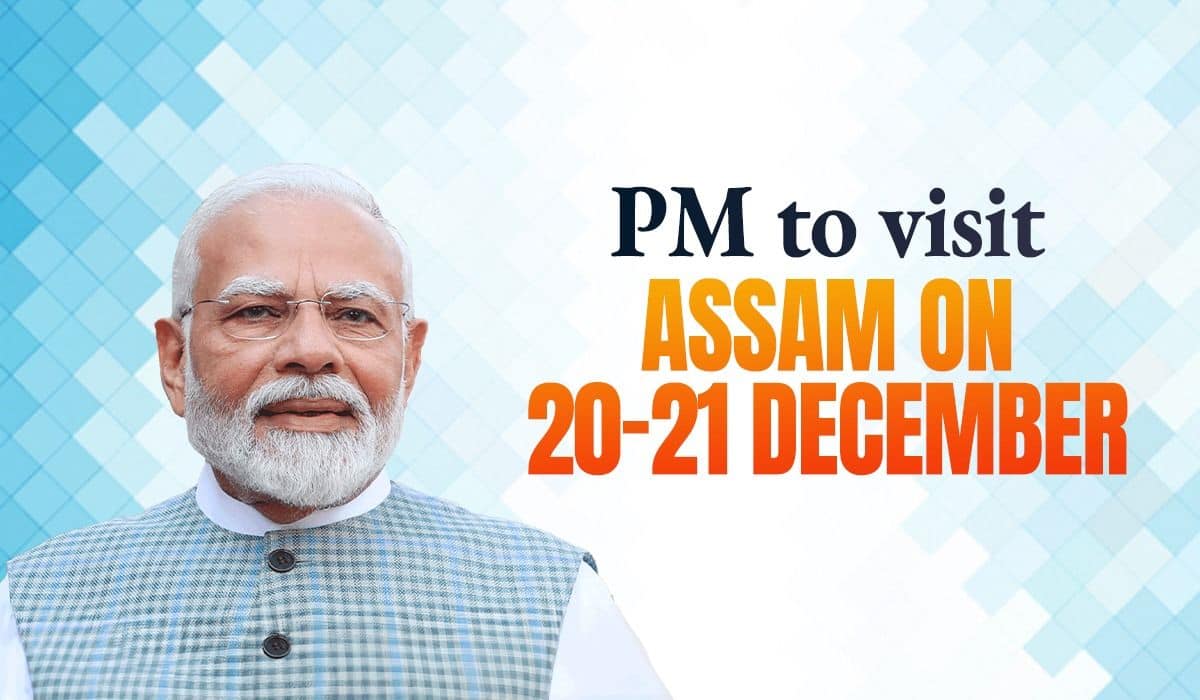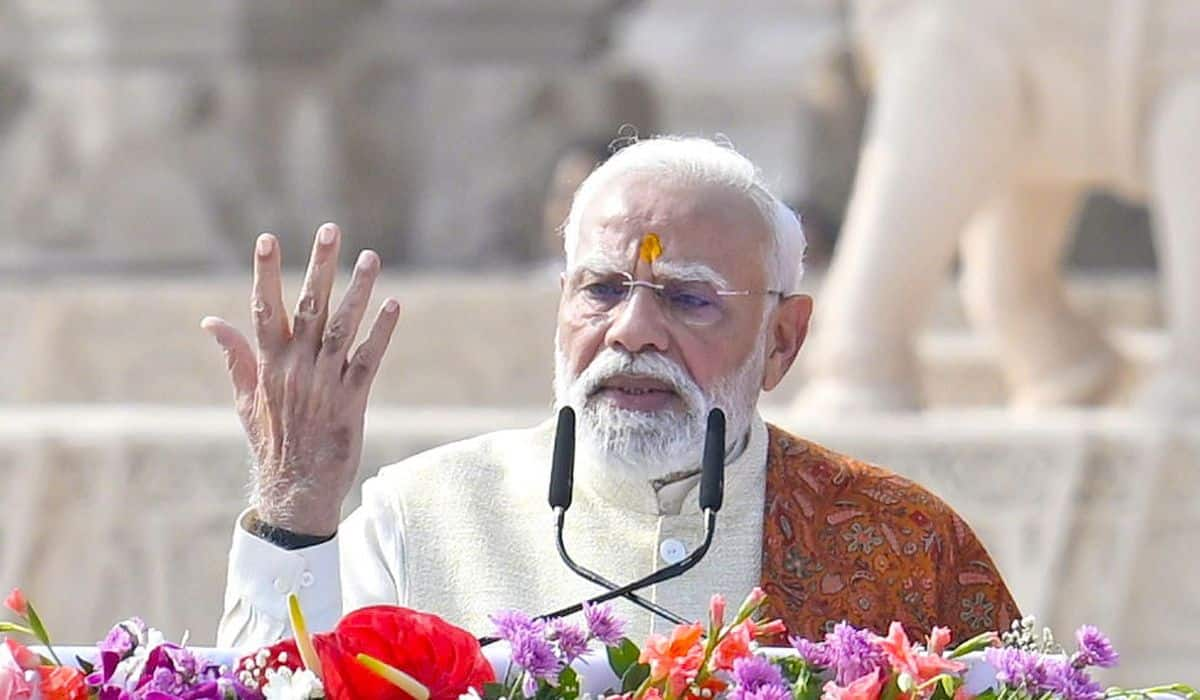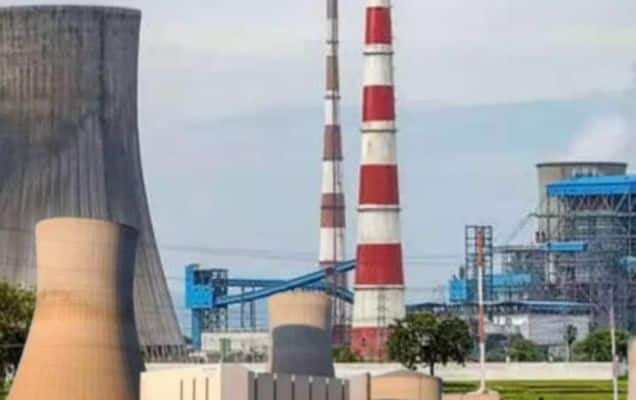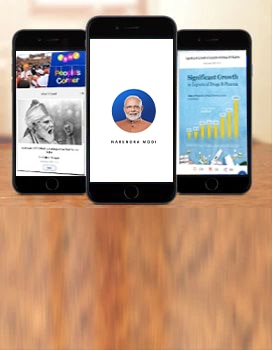Prime Minister Narendra Modi addressed a huge public meeting in Rohtak district of election-bound state of Haryana today.

Addressing the large crowd of enthusiastic supporters, PM Modi applauded the efficiency and transparency of the current BJP government in the state led by its CM Manohar Lal Khattar. He said, “The overwhelming crowd of supporters I see here are proof of CM Khattar’s mass popularity in Haryana.”

Describing how the BJP government transformed governance in the state since 2014, PM Modi said, “The last five years have seen Haryana progress rapidly with the ‘double-engine growth’ of BJP governments at the state and Centre levels. Currently, there are infrastructure projects worth more than 25,000 crore rupees under progress in Haryana. These projects will go a long way in enhancing ‘Ease of Living’ for people of the state.”

Shri Modi further asserted that the first 100 days of the Modi 2.0 government have been that of decisiveness and prioritising the nation before political gains. He added that the BJP always put the welfare of the poor and the marginalised first and will continue to do so in the future too.
Expressing satisfaction at the five year tenure of Haryana government, PM Modi remained confident that the BJP government would emerge victorious with a thundering majority in the upcoming Assembly elections.
हाल-फिलहाल के महीनों में तीसरी बार रोहतक आना हुआ है। पिछले साल चौधरी छोटू राम जी प्रतिमा के लोकार्पण के लिए आया था, फिर मई में आपको अपने काम का हिसाब देने आया और आज फिर आपके बीच में हूं।:PM
— narendramodi_in (@narendramodi_in) September 8, 2019
रोहतक की मेरी आज की यात्रा के पीछे दो बड़े मकसद हैं।
— narendramodi_in (@narendramodi_in) September 8, 2019
पहला मकसद, आपको विकास की नई परियोजनाओं का उपहार देने का और दूसरा मनोहर लाल जी को मिल रहे जबरदस्त समर्थन का साक्षी बनने का।: PM
मैं कह सकता हूं कि मनोहर लाल जी और उनकी सरकार ने जिस प्रकार हरियाणा के लोगों की सेवा की है, ये जन आशीर्वाद उसी का प्रतीक है।: PM
— narendramodi_in (@narendramodi_in) September 8, 2019
मनोहर लाल जी की जन आशीर्वाद यात्रा आज भले ही रोहतक में समाप्त हो रही है, लेकिन इससे साफ हो गया है कि आने वाले समय में भी हरियाणा का आशीर्वाद किसके साथ रहेगा।: PM
— narendramodi_in (@narendramodi_in) September 8, 2019
बीते 5 वर्ष में हरियाणा को भारतीय जनता पार्टी की केंद्र और राज्य सरकार के डबल इंजन का पूरा लाभ मिला है। अभी हरियाणा में केंद्र सरकार की मदद से लगभग 25 हज़ार करोड़ रुपए के बड़े प्रोजेक्ट्स पर काम चल रहा है।: PM
— narendramodi_in (@narendramodi_in) September 8, 2019
विकास के इसी सिलसिले को जारी रखते हुए थोड़ी देर पहले लगभग 2 हजार करोड़ रुपए की परियोजनाओं का शिलान्यास और उद्घाटन किया गया है। इसमें बेटियों की उच्च शिक्षा के लिए सिरसा, पलवल, हिसार और नूंह में डिग्री कॉलेज भी शामिल हैं।:PM
— narendramodi_in (@narendramodi_in) September 8, 2019
मुझे खुशी है कि बेटी बचाओ, बेटी पढ़ाओ अभियान को सफल बनाने के साथ ही यहां की बीजेपी सरकार बेटियों की शिक्षा पर व्यापक बल दे रही है। यहां आसपास के जिलों में बेटियों के अनुपात में जिस तरह वृद्धि हुई है, इसकी तो चर्चा पूरे देश में है।:PM
— narendramodi_in (@narendramodi_in) September 8, 2019
कॉलेज के साथ-साथ पानी की परियोजना, सोलर स्ट्रीट लाइट का काम, स्वास्थ्य से जुड़ी सुविधाएं, स्मार्ट व्यवस्थाओं से जुड़े प्रोजेक्ट का शुभारंभ भी आज हुआ है।:PM
— narendramodi_in (@narendramodi_in) September 8, 2019
इसके अलावा यहीं रोहतक में करीब 6 सौ गरीब परिवारों को घर भी दिए गए हैं और एक मेगा फूडपार्क का शिलान्यास भी किया गया है। ये फूड पार्क हरियाणा के किसानों के लिए, यहां के युवा साथियों के लिए आय के, रोज़गार के अनेक अवसर तैयार करने वाला है।:PM
— narendramodi_in (@narendramodi_in) September 8, 2019
इसके अलावा यहीं रोहतक में करीब 6 सौ गरीब परिवारों को घर भी दिए गए हैं और एक मेगा फूडपार्क का शिलान्यास भी किया गया है। ये फूड पार्क हरियाणा के किसानों के लिए, यहां के युवा साथियों के लिए आय के, रोज़गार के अनेक अवसर तैयार करने वाला है।:PM
— narendramodi_in (@narendramodi_in) September 8, 2019
आज मैं यहां आप सभी के प्रति, पूरे हरियाणा वासियों के प्रति आभार व्यक्त करने भी आया हूं। जिस प्रकार दिल खोलकर प्यार और अपनापन आपने लोकसभा के चुनावों में बीजेपी को दिया है, वो अभूतपूर्व है।: PM
— narendramodi_in (@narendramodi_in) September 8, 2019
ये संयोग ही है कि मैं हरियाणा ऐसे समय में आया हूं जब केंद्र में भाजपा-NDA की सरकार के नए कार्यकाल के भी 100 दिन हो रहे हैं।
— narendramodi_in (@narendramodi_in) September 8, 2019
ये 100 दिन, विकास के रहे हैं, विश्वास के रहे हैं, देश में बड़े परिवर्तन के रहे हैं।
ये 100 दिन, निर्णय के रहे हैं, निष्ठा के रहे हैं, नेक नीयत के रहे हैं:PM
ये 100 दिन, जन संकल्प के रहे हैं, जन सिद्धियों के रहे हैं, जनहित में सुधार के रहे हैं।:PM
— narendramodi_in (@narendramodi_in) September 8, 2019
बीते 100 दिन में जो भी बड़े फैसले लिए गए हैं, उनकी प्रेरणा और प्रोत्साहन आप सभी हैं, 130 करोड़ भारतवासी हैं। :PM
— narendramodi_in (@narendramodi_in) September 8, 2019
आपके अभूतपूर्व विश्वास के बल पर ही कृषि से लेकर राष्ट्र की रक्षा-सुरक्षा से जुड़े बड़े निर्णय सरकार ले पाई है। आतंकवाद से निपटने के लिए, मुस्लिम बहनों के अधिकारों की सुरक्षा के लिए और हमारे हेल्थ सेक्टर की बेहतरी के लिए अनेक क़ानून बनाए गए हैं।:PM
— narendramodi_in (@narendramodi_in) September 8, 2019
इसी तरह अर्थव्यवस्था को सशक्त बनाने के लिए अलग-अलग सेक्टर्स को मदद करने का रोडमैप रखा गया है। देश में बैंकिंग व्यवस्था को मजबूत करने के लिए ऐतिहासिक फैसले भी लिए गए हैं। ये अभी शुरुआत है, जिसका निश्चित लाभ आने वाले समय में मिलेगा।:PM
— narendramodi_in (@narendramodi_in) September 8, 2019
इसके अलावा इन 100 दिनों में एक और महत्वपूर्ण काम हुआ है। इस दौरान संसद के सत्र में जितने बिल पास हुए हैं, जितना काम हुआ है, उतना किसी सत्र में पिछले 6 दशक में नहीं हुआ। बहुत देर रात तक बैठकर नए कानूनों पर चर्चा की गई है।:PM
— narendramodi_in (@narendramodi_in) September 8, 2019
ये मंच बीजेपी का है लेकिन संसद में रिकॉर्ड कार्यों के लिए मैं सभी दलों को धन्यवाद देता हूं।:PM
— narendramodi_in (@narendramodi_in) September 8, 2019
बीते 100 दिन में देश और दुनिया ने देखा है कि हर चुनौती को चाहे वो दशकों पुरानी हो या फिर भविष्य की हो, भारत अब हर चुनौती से सीधे टकराने वाला है।:PM
— narendramodi_in (@narendramodi_in) September 8, 2019
जम्मू कश्मीर और लद्दाख का मामला हो या फिर गंभीर होता जल संकट, 130 करोड़ देशवासियों ने मिलकर नए समाधान तलाशने शुरू कर दिए हैं।
— narendramodi_in (@narendramodi_in) September 8, 2019
जम्मू कश्मीर के, लद्दाख के करोड़ों साथियों के साथ मिलकर एक नई सोच के साथ, उनके सपनों को, आकांक्षाओं को, पूरा करने में हम जुट गए हैं।:PM
हमने संकल्प लिया था कि, पीएम किसान सम्मान निधि का लाभ देश के हर किसान परिवार को दिलाएंगे। सरकार बनते ही इसको लागू कर दिया गया है। अभी तक देशभर में इस योजना के तहत देश के 7 करोड़ से अधिक किसान परिवारों को लाभ मिल चुका है, जिसमें से 13 लाख से अधिक परिवार सिर्फ हरियाणा के ही हैं:PM
— narendramodi_in (@narendramodi_in) September 8, 2019
इतने कम समय में ही देशभर के किसानों के खाते में 21 हज़ार करोड़ रुपए, तो हरियाणा के किसानों के खाते में सवा 4 सौ करोड़ रुपए जमा हो चुके हैं।:PM
— narendramodi_in (@narendramodi_in) September 8, 2019
किसान परिवारों के लिए ही पेंशन का एक और बड़ा संकल्प आपके सामने भाजपा ने रखा था। बुढ़ापे में सहारा देने वाली, हर महीने 3 हज़ार रुपए की नियमित पेंशन सुनिश्चित करने वाली ये योजना भी शुरु हो चुकी है।:PM
— narendramodi_in (@narendramodi_in) September 8, 2019
बहुत ही कम समय में देशभर के करीब 8 लाख किसान भाई-बहन इस योजना से जुड़ चुके हैं। इनमें से 33 हज़ार से अधिक हरियाणा के हैं।:PM
— narendramodi_in (@narendramodi_in) September 8, 2019
किसानों के हित में ऐसे अनेक प्रयास हो रहे हैं जिनके बल पर 2022 तक आमदनी दोगुनी करने का लक्ष्य पूरा करने का प्रयास किया जाएगा। किसानों की लागत कम हो, फसल का उचित दाम उन्हें मिले, उपज की बर्बादी ना हो इसके लिए निरंतर काम चल रहा है।:PM
— narendramodi_in (@narendramodi_in) September 8, 2019
रोहतक में बनने वाला मेगा फूड पार्क ऐसी ही कोशिशों का एक हिस्सा है। इस फूड पार्क से हरियाणा के हजारों किसानों और व्यापारियों को फायदा होने वाला है। इसके साथ-साथ फूड पार्क से करीब-करीब 7 हजार लोगों को रोजगार मिलेगा।PM
— narendramodi_in (@narendramodi_in) September 8, 2019
भाजपा का एक और संकल्प है जिस पर बहुत बड़े पैमाने पर काम शुरु कर दिया गया है। साल 2024 तक देश के हर घर तक जल पहुंचाने के लिए देश जुट चुका है। जल जीवन मिशन पर पूरा देश जुट चुका है। हरियाणा भी इसमें बढ़-चढ़कर हिस्सा ले रहा है।:PM
— narendramodi_in (@narendramodi_in) September 8, 2019
ये तय किया गया है कि पानी को बचाने और घर-घर जल पहुंचाने के लिए आने वाले 5 वर्षों में साढ़े 3 लाख करोड़ रुपए खर्च किए जाएंगे। इसका लाभ हरियाणा को भी मिलने वाला है।:PM
— narendramodi_in (@narendramodi_in) September 8, 2019
हम सब जानते हैं कि भारत में स्वास्थ्य सेवाओं में सुधार करने की आवश्यकता है। लेकिन ऐसा रोडमैप पहले किसी के पास नहीं था, जिसमें 130 करोड़ देशवासियों के स्वास्थ्य की चिंता समाहित हो। :PM
— narendramodi_in (@narendramodi_in) September 8, 2019
इसी सोच के साथ कुछ दिन पहले ही हरियाणा में 10 आयुष हेल्थ एंड वेलनेस सेंटर की शुरुआत मैंने दिल्ली से की थी। आज गुरुग्राम में नए मेडिकल कॉलेज का शिलान्यास किया गया है। इससे स्वास्थ्य सुविधाएं भी बढ़ेगी और हमारे युवाओं को मेडिकल की पढ़ाई के लिए अधिक अवसर भी मिलेंगे।:PM
— narendramodi_in (@narendramodi_in) September 8, 2019
आयुष्मान भारत ने गरीबों का मुफ्त इलाज सुनिश्चित किया है। जन औषधि योजना से सस्ती दवाइयां मिल रही हैं। जीवन रक्षक दवाइयों की कीमतों को भी नियंत्रित किया गया है।:PM
— narendramodi_in (@narendramodi_in) September 8, 2019
लोकसभा चुनाव में आपने भारत के भविष्य को ध्यान में रखते हुए जनादेश दिया था। अब हरियाणा के भविष्य के लिए बीते 5 वर्षों की निरंतरता को आने वाले 5 वर्षों के लिए जारी रखने का समय है।:PM
— narendramodi_in (@narendramodi_in) September 8, 2019
हरियाणा की भाजपा सरकार, राज्य के गौरव को बढ़ाने वाले कार्य कर रही है। आज स्वच्छ भारत की बात करें तो हरियाणा पूरे देश में अव्वल राज्यों में एक है। हरियाणा ने अपने आप को पूरी तरह से ODF मुक्त घोषित कर लिया है।:PM
— narendramodi_in (@narendramodi_in) September 8, 2019
इसके अलावा हरियाणा केरोसीन मुक्त राज्य बन चुका है और MSME सेक्टर में भी देश के टॉप राज्यों में हरियाणा का नाम है।:PM
— narendramodi_in (@narendramodi_in) September 8, 2019
बीते 5 वर्षों में, हरियाणा के सरकारी सिस्टम से अपने-पराए का भेद करने वाली मानसिकता पर चोट की गई है।
— narendramodi_in (@narendramodi_in) September 8, 2019
बीते 5 वर्षों में, हरियाणा में परिवारवाद और भ्रष्टाचार पर कड़ा प्रहार किया गया है।PM
बीते 5 वर्षों में, हरियाणा में सरकारी नौकरियों में बंदरबांट की एक गलत परंपरा को खत्म किया गया है।
— narendramodi_in (@narendramodi_in) September 8, 2019
बीते 5 वर्षों में, बेरोजगार युवाओं के कौशल से लेकर उनको मिलने वाली मदद तक में वृद्धि की गई है।PM
बीते 5 वर्षों में, हरियाणा में किसानों की जमीन पर भ्रष्टाचार का जो खेल चलता था, वो भी बंद हो गया है।
— narendramodi_in (@narendramodi_in) September 8, 2019
5 वर्षों के ऐसे बेहतरीन ट्रैक रिकॉर्ड के दम पर ही पूरा हरियाणा आज भाजपा के पक्ष में खड़ा है।PM
मुझे पूरा विश्वास है कि भाजपा के साथ, मनोहर लाल जी के साथ रोहतक के, हरियाणा के जन-जन का ये विश्वास ऐसे ही बना रहेगा।
— narendramodi_in (@narendramodi_in) September 8, 2019
एक बार फिर विकास परियोजनाओं के लिए आपको बधाई। आप भारी संख्या में यहां हम सभी को आशीर्वाद देने आए, इसके लिए आपका आभार।PM














